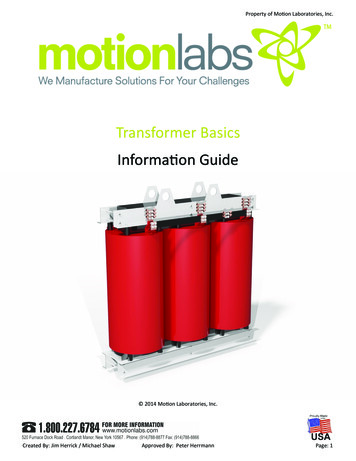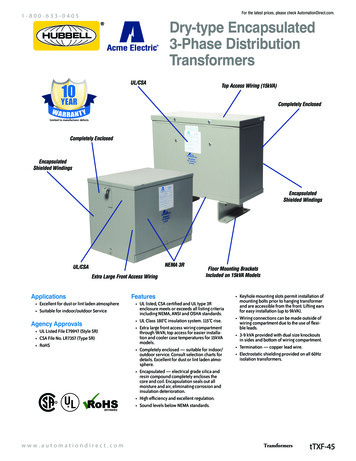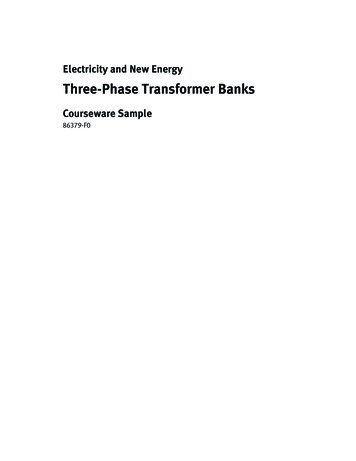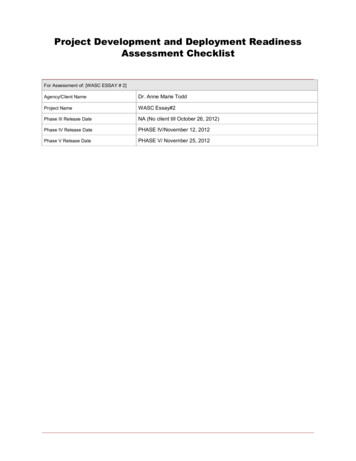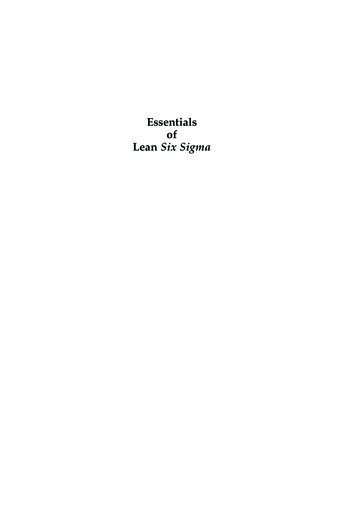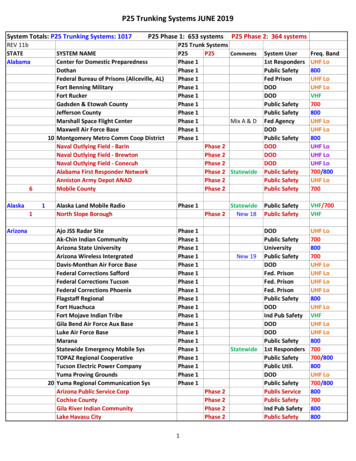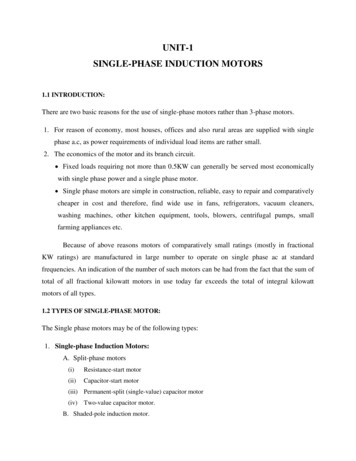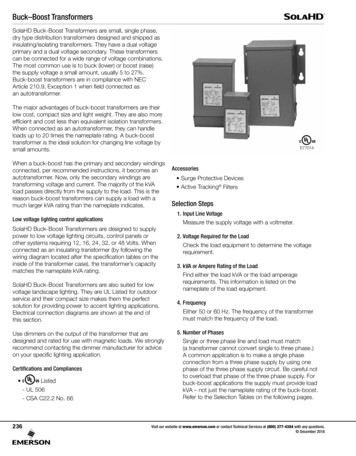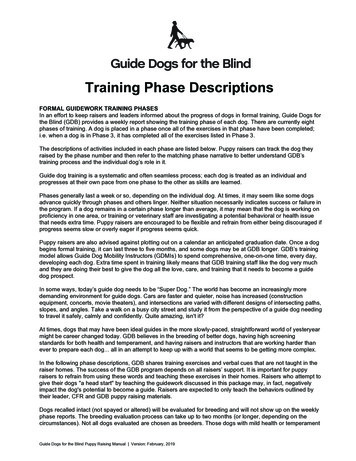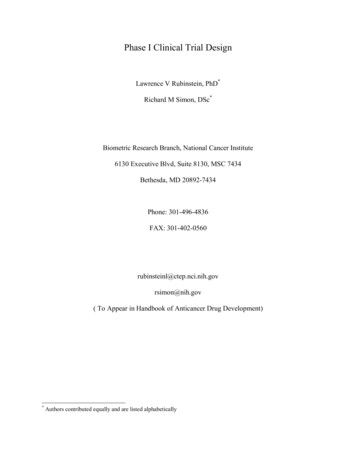
Transcription
Design of Phase II Clinical TrialsCLINICAL AND TRANSLATIONAL SCIENCE CENTERSusan Stewart, Ph.D.Division of Biostatisticsand Translational Science CenterThe UC Davis CTSC receives support fromClinicalthe NIHNational Center for Advancing Translational Sciences (award TR001860).1
Topics Objectives Typeso Multi-stageo Randomizedo Platformo CrossoverClinical and Translational Science Center2
Phase II clinical trials Phase II (NIH definition): Study the biomedical or behavioralintervention in a larger group of people (several hundred) todetermine efficacy and further evaluate safety.o Is there any biological activity?o May or may not have concurrent controlso May be shorter term with different outcome and more exclusioncriteria than phase III trialso Phase IIA-evaluate dosing; phase IIB –determine effectivenessClinical and Translational Science Center3
Phase II: Multi-stage designs Purposeo Identify drugs that are promising for further testing in a Phase IIItrialo Preliminary efficacy assessmento Avoid exposing patients to sub-therapeutic dose levelso Terminate the study if the treatment is ineffectiveClinical and Translational Science Center4
Single arm trials Optimal two-stage designso Permit early stopping if there is a moderately long sequence ofinitial failureso Enroll n1 patients in stage 1o If r1 responses, stop the trialo Otherwise, enroll n2 more patientso Decide whether or not treatment is promising based on the n1 n2patientsClinical and Translational Science Center5
Two-stage designs Null hypothesis: probability of response is unacceptably low Alternative hypothesis: probability of response is sufficiently high towarrant further study Simon’s optimal two-stage design minimizes the expected samplesize under the null hypothesis for the given error constraints Simon’s minimax design minimizes the maximum sample size for thegiven error constraintsClinical and Translational Science Center6
Example: Intravenous aflibercept in patients with ovarian cancer Drug is a vascular endothelial growth factor (VEGF) inhibitor 2 dose levels tested (2 mg/kg and 4 mg/kg), based on previous phase 1 & 2 studies Patients with advanced platinum-resistant ovarian cancer Simon minimax 2-stage design Primary outcome: objective response rate (ORR) Null hypothesis: ORR 5% Alternative hypothesis: ORR 15% Tested at the 0.025 level, 1-sidedTew et al. Cancer 2014; 120:335-43Clinical and Translational Science Center7
2-stage design Plan: enroll 42 patients in each group in stage 1 If at least 3 responders in stage 1in a group, go on to enroll 25patients in stage 2 Declare drug suitable for future study if at least 8 responders total(stages 1 & 2) in a group Allowed to enroll additional patients beyond the 2-stage design toreach a planned total sample size of 200Clinical and Translational Science Center8
Sample size gram/ivanova/SimonsTwoStageDesign.aspxClinical and Translational Science Center9
Multiple stage designs Can extend to 3 (or even 4 stages) May require at least one response at first stage to go on to thesecond stage Considerations for any multi-stage designo How long will it take to determine whether there are enough responses toproceed to the next stage?o Will we stop the study or keep on enrolling while waiting for the resultsfrom the previous stage?Clinical and Translational Science Center10
Randomized phase II designs May randomize patients to different drugs or dose levels of the samedrug Can estimate differences between treatments Can pick the treatment with best response Randomization produces balanced groupsClinical and Translational Science Center11
Example: Phase II trial—Oncken (2006) Background: Evaluated 4 varenicline dose regimens for promoting smokingcessation. Methods: Multicenter, double-blind, placebo-controlled. Randomizedhealthy smokers aged 18-65 to varenicline tartrate or placebo twice daily for12 weekso 0.5 mg non-titrated (n 129); 0.5 mg titrated (n 130)o 1.0 mg non-titrated (n 129); 1.0 mg titrated (n 130)o placebo (n 129)with 40-week follow-up to assess long-term efficacy.Primary efficacy outcomes: carbon-monoxide confirmed 4-week continuousquit rates; continuous abstinenceArch Intern Med. 2006 166(15):1571-7Clinical and Translational Science Center12
Data Analysis Quit rates: binaryo Compared each treatment group separately vs. placeboo Compared pooled dosage groups vs. placeboo Step-down procedure to account for multiple comparisonso Logistic regression Independent variables: treatment and center Computed odds ratios with 95% confidence intervals MNWS (withdrawal), mCEQ (cigarette evaluation): numerico Analysis of covariance (ANCOVA) Covariate: baseline level of outcome variable Independent variables: treatment and centerClinical and Translational Science Center13
Results Weeks 9-12 continuous quit rates greater in 1.0 mg group and 0.5 mggroup than placebo Weeks 9-52 abstinence rates greater in 1.0 mg group and 0.5 mggroup than placebo Generally well toleratedo Nausea in 16%-42% of varenicline treated subjectso Less nausea with titrated dosingClinical and Translational Science Center14
From: Efficacy and Safety of the Novel Selective Nicotinic Acetylcholine Receptor Partial Agonist, Varenicline,for Smoking CessationArch Intern Med. 2006;166(15):1571-1577. doi:10.1001/archinte.166.15.1571Figure Legend:Continuous quit rates. P .001 for each treatment group vs placebo. BID indicates twice daily. The odds ratios (ORs) and 95%confidence intervals (CIs) for the weeks 4 through 7 evaluation were 4.96 (95% CI, 2.66-9.22) for the 0.5-mg group and 5.86 (95%CI, 3.16-10.90) for the 1.0-mg group; for the weeks 9 through 12 evaluation, 6.32 (95% CI, 3.47-11.50) and 8.07 (95% CI, 4.4214.70), respectively.Date of download: 3/30/2014Clinical and Translational Science CenterCopyright 2014 American MedicalAssociation. All rights reserved.15
From: Efficacy and Safety of the Novel Selective Nicotinic Acetylcholine Receptor Partial Agonist, Varenicline,for Smoking CessationArch Intern Med. 2006;166(15):1571-1577. doi:10.1001/archinte.166.15.1571Figure Legend:Carbon monoxide–confirmed weekly point prevalence abstinence rates. BID indicates twice daily. *P .001 vs placebo.Date of download: 3/30/2014Clinical and Translational Science CenterCopyright 2014 American MedicalAssociation. All rights reserved.16
From: Efficacy and Safety of the Novel Selective Nicotinic Acetylcholine Receptor Partial Agonist, Vrenicline,for Smoking CessationArch Intern Med. 2006;166(15):1571-1577. doi:10.1001/archinte.166.15.1571Figure Legend:Mean changes in Minnesota Nicotine Withdrawal Scale “urge to smoke” scores from week 1 to week 12 for all subjects. BIDindicates twice daily. In comparison with placebo, asterisk indicates P .001; dagger, P .01; and double dagger, P .05.Date of download: 3/30/2014Clinical and Translational Science CenterCopyright 2014 American MedicalAssociation. All rights reserved.17
Conclusion Varenicline tartrate , 0.5 mg and 1.0 mg twice daily, is efficacious forsmoking cessation.Clinical and Translational Science Center18
Platform Trials Multiple treatments evaluated simultaneously Single master protocol Adaptive platform designso Drop treatments for futilityo Declare one or more treatments superioro Add new treatments Multi-arm, multi-stage More efficient than traditional RCT designsSaville & Berry. Efficiencies of platform clinical trials: A vision of thefuture. Clin Trials. 2016 Jun;13(3):358-66.Park et al. An overview of platform trials with a checklist for clinicalreaders. J Clin Epidemiol. 2020 Sep;125:1-8.Clinical and Translational Science Center19
Park et al. An overview of platform trials with a checklist for clinicalreaders. J Clin Epidemiol. 2020 Sep;125:1-8.Clinical and Translational Science Center20
Example: ACCORD Seamless Phase 2 Platform Studyto Assess Multiple COVID-19 Treatments Objectives:o Stage 1 (screening stage): Evaluate safety and efficacy of candidate agents asadd-on therapy to standard of care (SoC) in hospitalized patientso Stage 2 (expansion stage): Confirm efficacy of agents selected based onevidence from Stage 1 Participants:o Hospitalized patients age 18 with Grade 3-5 COVID-19 in UK Main outcomes:o Time to sustained clinical improvement 2 points on WHO 9 point ordinal scaleo Live discharge or fit for discharge (0-2 on WHO scale) by Day 29Wilkinson et al. Trials (2020) 21:691Clinical and Translational Science Center21
ACCORD trial (cont’d) Comparator and candidate interventionso Current SoC for COVID-19o Bemcentinibooooo Could reduce viral infection; blocks spike proteinMEDI3506 Anti-IL-33 monoclonal antibody; could treat respiratory failureAcalabrutinib BTK inhibitor; anti-viral and anti-inflammatoryZilucoplan Complement C5 inhibitor; may block severe inflammatory responseNebulized heparin Binds with spike proteinOthers TBDClinical and Translational Science Center22
ACCORD trial (cont’d) Randomizationo Stratified by baseline severity gradeo Equal allocation to each experimental arm and contemporaneous SoC armo May be changed to 2:1 in favor of experimental arms Sample size per agento Stage 1: 60o Stage 2: 126o Total: up to 1800Clinical and Translational Science Center23
Crossover Trial Definition (Chow & Liu): Modified randomized block design in which eachblock receives more than one treatment at different dosing periods. Simplest case: each participant is randomized to receive 2 treatments, Aand B, in the order AB or BA. Between the 2 treatments, there is a washout period.Design and Analysis of Clinical Trials (3rdEd.) Chow & Liu, Wiley, 2014Clinical and Translational Science Center24
Crossover Trial Advantageso Each participant serves as his or her own controlo Removes inter-patient variability from the comparison of treatmentso Therefore, requires a smaller sample size than a parallel groups design Disadvantageo Have to worry about carryover between treatments Carryover effects may not be equalo Vulnerable to dropoutsClinical and Translational Science Center25
Higher Order Crossover Designs Definition (Chow & Liu):o Number of periods number of treatments Two-sequence dual (extra period) design: ABB, BAA Doubled (replicated) design: AABB, BBAAo Number of sequences number of treatments Balaam’s design: AA, BB, AB, BAo Both Four-sequence design: AABB, BBAA, ABBA, BAAB These designs allow estimation of carryover effects and intra-patient variabilityClinical and Translational Science Center26
Crossover Trial Example: Randomized double blind trial of dark chocolate/cocoasnack vs. control snack in overweight people aged 40-64 (n 30) 2 periods, 4 weeks each, with 2-week washout period Outcomes: large & small blood vessel dilatation, peripheral bloodflow, arterial stiffness Comparison: Active vs. control & baselineWest et al., British Journal of Nutrition 2014; 111:653-61Clinical and Translational Science Center27
Data Analysis Initial modelo Fixed effects: treatment (baseline, active, control), period, treatment Xperiod interactiono Random effect: participant Treatment X period was not statistically significant Some models included treatment X sex interaction Tukey’s post-hoc tests for multiple comparisonsClinical and Translational Science Center28
Table 4: ResultsMean values were significantly different from those of the activegroup: * P 0·05, ** P 0·01, *** P 0·001.Clinical and Translational Science Center29
Fig. 1 Sex difference in vascular response to the cocoa dark chocolate treatment.Women () exhibited significant reductions in the augmentation index, whereasmen () did not (sex treatment interaction, P 0·01).Clinical and Translational Science Center30
2-Period 2-Treatment Crossover Trial: Outcome bySequence & PeriodSequenceABBAPeriod 1YAYBClinical and Translational Science CenterPeriod 2YBYA31
Simplifying Assumptions H0: μB μA; Ha: μB μA Specify μB-μA δ(difference in treatment effects) No sequence or period effect: paired t-test comparing treatment B withtreatment A over the entire sampleo Specify SD 2*(within-person SD) SD(YB-YA)o Or specify SD(YB), SD(YA), and corr(YA,YB)Clinical and Translational Science Center32
https://stattools.crab.orgClinical and Translational Science Center33
Crossover Trial vs. Parallel Group Sample Size For a giveno difference in treatment mean responses μB-μA δo treatment response variance Var(Y) (between-person plus within-person)o levels of type I & II errorn crossover 0.5*[1-corr(YB,YA)]n parallelo Even if there is no within-person correlation, the crossover trial requires half thesample sizeo The greater the correlation, the greater the reduction in sample sizeClinical and Translational Science Center34
Considerations If intra-patient variability inter-patient variability, parallel groupspreferred to crossover If inter-patient variability is large and the number of treatments is small,consider a cross-over design However, disease state must be stableClinical and Translational Science Center35
Selecting a design Need to consider (Chow & Liu)o Number of treatments to be comparedo Characteristics of the treatmento Study objectiveso Availability of participantso Inter- and intra-person variabilityo Duration of the studyo Dropout ratesClinical and Translational Science Center36
Compared each treatment group separately vs. placebo o Compared pooled dosage groups vs. placebo o Step-down procedure to account for multiple comparisons o Logistic regression Independent variables: treatment and center Computed odds ratios with 95% confidence intervals MNWS (withdrawal), mCEQ (cigarette evaluation): numeric o
